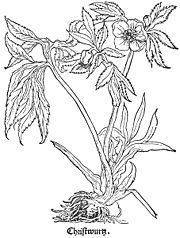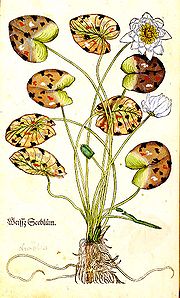
Otto Brunfels
Encyclopedia
Otto Brunfels (believed to be born in 1488 near Mainz
- December 23, 1534 in Bern, Switzerland
) was a German theologian and botanist. Carl von Linné listed him among the "Fathers of Botany".
and philosophy
at the University of Mainz, Brunfels entered a Carthusian
monastery in Mainz and later resettled to another Carthusian monastery at Königshofen near Strasbourg
. In Strasbourg he got in contact with a learned lawyer Nikolaus Gerbel
(they met in person in 1519). Gerbel drew Brunfels' attention to the healing powers of plants and thus gave the impetus to the further botanical investigations.
 After the conversion to the Protestantism (he was supported by Franz von Sickingen
After the conversion to the Protestantism (he was supported by Franz von Sickingen
and Ulrich von Hutten
), upon the insistence of the Dean of Frankfurt Johann Indagine, Brunfels became a minister at Steinau an der Straße (1521) and later, in Neuenburg am Rhein. After that he served for eight years as the head of a Carmelite school in Strasbourg
. In the list of most important heretics published by the order of the Emperor by the University of Leuven (1550), Brunfels was listed first.
In one of his works he defended Ulrich von Hutten against Erasmus of Rotterdam and published the manuscripts from the Jan Hus
heritage. Brunfels' Catalogi virorum illustrium 1527 is considered to be the first book on the history of evangelical
Church.
After his friend Ulrich von Hutten had died (1523), Brunfels' religious views brought him into a controversy with Martin Luther
and Huldrych Zwingli
. Later on he began to study medicine
at the University of Basel
, (M.D.
1530). In 1532 Brunfels became a City physician in Bern, where he stayed till the end of his life.
Besides of his numerous theological works, Brunfels published treatises on pedagogics, Arabic language
, pharmaceutics
, entomology
and
botany
. He is often called a father of botany, because, in his botanical writings, he relied not so much on the ancient authors as on his own observations and described plants according to the latter. In his Herbarium vivae icones (1530 and 1536, in three parts) and Contrafayt Kräuterbuch (1532-1537, in two parts), the German plants he himself found during his botanical studies are represented with woodcuts (by Hans Weiditz
) under their German
vernacular
names. However, Duane Isely attributes much of Brunfels' popularity to Weiditz, whose woodcuts set a new standard technically, and were done from life, rather being copied from previous works. Brunfels also introduced information about German plants not found in Dioscorides, and described them independently of their medical values, although the descriptions are often poorly-written.
A plant genus Brunfelsia
(Solanaceae) is named after him.

Mainz
Mainz under the Holy Roman Empire, and previously was a Roman fort city which commanded the west bank of the Rhine and formed part of the northernmost frontier of the Roman Empire...
- December 23, 1534 in Bern, Switzerland
Switzerland
Switzerland name of one of the Swiss cantons. ; ; ; or ), in its full name the Swiss Confederation , is a federal republic consisting of 26 cantons, with Bern as the seat of the federal authorities. The country is situated in Western Europe,Or Central Europe depending on the definition....
) was a German theologian and botanist. Carl von Linné listed him among the "Fathers of Botany".
Life
After studying theologyTheology
Theology is the systematic and rational study of religion and its influences and of the nature of religious truths, or the learned profession acquired by completing specialized training in religious studies, usually at a university or school of divinity or seminary.-Definition:Augustine of Hippo...
and philosophy
Philosophy
Philosophy is the study of general and fundamental problems, such as those connected with existence, knowledge, values, reason, mind, and language. Philosophy is distinguished from other ways of addressing such problems by its critical, generally systematic approach and its reliance on rational...
at the University of Mainz, Brunfels entered a Carthusian
Carthusian
The Carthusian Order, also called the Order of St. Bruno, is a Roman Catholic religious order of enclosed monastics. The order was founded by Saint Bruno of Cologne in 1084 and includes both monks and nuns...
monastery in Mainz and later resettled to another Carthusian monastery at Königshofen near Strasbourg
Strasbourg
Strasbourg is the capital and principal city of the Alsace region in eastern France and is the official seat of the European Parliament. Located close to the border with Germany, it is the capital of the Bas-Rhin département. The city and the region of Alsace are historically German-speaking,...
. In Strasbourg he got in contact with a learned lawyer Nikolaus Gerbel
Nikolaus Gerbel
Nikolaus Gerbel was a German humanist, jurist and doctor of both laws.Nikolaus Gerbel was part of a circle of literary men living in Strasbourg...
(they met in person in 1519). Gerbel drew Brunfels' attention to the healing powers of plants and thus gave the impetus to the further botanical investigations.

Franz von Sickingen
Franz von Sickingen was a German knight, one of the most notable figures of the first period of the Reformation.-Biography:He was born at Ebernburg near Bad Kreuznach...
and Ulrich von Hutten
Ulrich von Hutten
Ulrich von Hutten was a German scholar, poet and reformer. He was an outspoken critic of the Roman Catholic Church and a bridge between the humanists and the Lutheran Reformation...
), upon the insistence of the Dean of Frankfurt Johann Indagine, Brunfels became a minister at Steinau an der Straße (1521) and later, in Neuenburg am Rhein. After that he served for eight years as the head of a Carmelite school in Strasbourg
Strasbourg
Strasbourg is the capital and principal city of the Alsace region in eastern France and is the official seat of the European Parliament. Located close to the border with Germany, it is the capital of the Bas-Rhin département. The city and the region of Alsace are historically German-speaking,...
. In the list of most important heretics published by the order of the Emperor by the University of Leuven (1550), Brunfels was listed first.
In one of his works he defended Ulrich von Hutten against Erasmus of Rotterdam and published the manuscripts from the Jan Hus
Jan Hus
Jan Hus , often referred to in English as John Hus or John Huss, was a Czech priest, philosopher, reformer, and master at Charles University in Prague...
heritage. Brunfels' Catalogi virorum illustrium 1527 is considered to be the first book on the history of evangelical
Protestantism
Protestantism is one of the three major groupings within Christianity. It is a movement that began in Germany in the early 16th century as a reaction against medieval Roman Catholic doctrines and practices, especially in regards to salvation, justification, and ecclesiology.The doctrines of the...
Church.
After his friend Ulrich von Hutten had died (1523), Brunfels' religious views brought him into a controversy with Martin Luther
Martin Luther
Martin Luther was a German priest, professor of theology and iconic figure of the Protestant Reformation. He strongly disputed the claim that freedom from God's punishment for sin could be purchased with money. He confronted indulgence salesman Johann Tetzel with his Ninety-Five Theses in 1517...
and Huldrych Zwingli
Huldrych Zwingli
Ulrich Zwingli was a leader of the Reformation in Switzerland. Born during a time of emerging Swiss patriotism and increasing criticism of the Swiss mercenary system, he attended the University of Vienna and the University of Basel, a scholarly centre of humanism...
. Later on he began to study medicine
Medicine
Medicine is the science and art of healing. It encompasses a variety of health care practices evolved to maintain and restore health by the prevention and treatment of illness....
at the University of Basel
University of Basel
The University of Basel is located in Basel, Switzerland, and is considered to be one of leading universities in the country...
, (M.D.
Doctor of Medicine
Doctor of Medicine is a doctoral degree for physicians. The degree is granted by medical schools...
1530). In 1532 Brunfels became a City physician in Bern, where he stayed till the end of his life.
Besides of his numerous theological works, Brunfels published treatises on pedagogics, Arabic language
Arabic language
Arabic is a name applied to the descendants of the Classical Arabic language of the 6th century AD, used most prominently in the Quran, the Islamic Holy Book...
, pharmaceutics
Pharmaceutics
Pharmaceutics is the discipline of pharmacy that deals with all facets of the process of turning a new chemical entity into a medication able to be safely and effectively used by patients in the community. Pharmaceutics is the science of dosage form design...
, entomology
Entomology
Entomology is the scientific study of insects, a branch of arthropodology...
and
botany
Botany
Botany, plant science, or plant biology is a branch of biology that involves the scientific study of plant life. Traditionally, botany also included the study of fungi, algae and viruses...
. He is often called a father of botany, because, in his botanical writings, he relied not so much on the ancient authors as on his own observations and described plants according to the latter. In his Herbarium vivae icones (1530 and 1536, in three parts) and Contrafayt Kräuterbuch (1532-1537, in two parts), the German plants he himself found during his botanical studies are represented with woodcuts (by Hans Weiditz
Hans Weiditz
Hans Weiditz the Younger, Hans Weiditz der Jüngere, Hans Weiditz II , was a German Renaissance artist, also known as The Petrarch Master for his woodcuts illustrating Petrarch's De remediis utriusque fortunae, or Remedies for Both Good and Bad Fortune, or Phisicke Against Fortune...
) under their German
German language
German is a West Germanic language, related to and classified alongside English and Dutch. With an estimated 90 – 98 million native speakers, German is one of the world's major languages and is the most widely-spoken first language in the European Union....
vernacular
Vernacular
A vernacular is the native language or native dialect of a specific population, as opposed to a language of wider communication that is not native to the population, such as a national language or lingua franca.- Etymology :The term is not a recent one...
names. However, Duane Isely attributes much of Brunfels' popularity to Weiditz, whose woodcuts set a new standard technically, and were done from life, rather being copied from previous works. Brunfels also introduced information about German plants not found in Dioscorides, and described them independently of their medical values, although the descriptions are often poorly-written.
A plant genus Brunfelsia
Brunfelsia
Brunfelsia is a genus of about 40 species of neotropical shrubs and small trees.The leaves are alternate and simple, with shapes generally elliptic to ovate. The flowers are large and tubular, with five broad petals. Typical habitat is light woodland and thickets. Species in cultivation include...
(Solanaceae) is named after him.
Works

- Othonis Brvnfelsii Pro Vlricho Hutteno defuncto ad Erasmi Roter. Spongiam Responsio (1523)
- Processus consistorialis Martyrii Io. Huss (1524); German edition: Geistl. Bluthandel Iohannis Hussz zu Constenz (1524 or 1525)
- Pandectarum Veteris et Novi Testamenti (1527)
- Catalogi virorum illustrium veteris et novi testamenti (1527)
- Catechesis puerorum in fide, in literis et in moribus (1529)
- Herbarum vivae eicones, 3 Bde. (1530-36)
- Catalogus illustrium medicorum seu de primis medicinae scriptoribus (1530)
- Iatron medicamentorum simplicium (1533)
- Contrafayt Kreüterbuch (mit naturgetreuen Abb. v. Hans Weiditz), 2 Vol., (1532-1537)
- Onomastikon medicinae, continens omnia nomina herbarum, fruticum etc. (1534)
- Epitome medices, summam totius medicinae complectens (1540)
- In Dioscoridis historiam plantarum certissima adaptatio (1543)
Sources
- Meyers Konversationslexikon 1888-1889
- Jahn, I. Geschichte der Biologie. Spektrum 2000
- Mägdefrau, K. Geschichte der Botanik. Fischer 1992
- Duane Isely, One hundred and one botanists (Iowa State University Press, 1993), pp. 17–19

